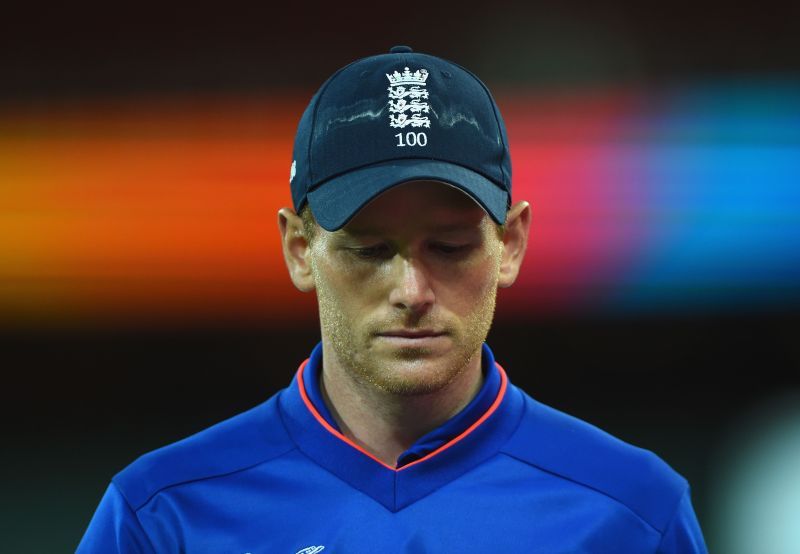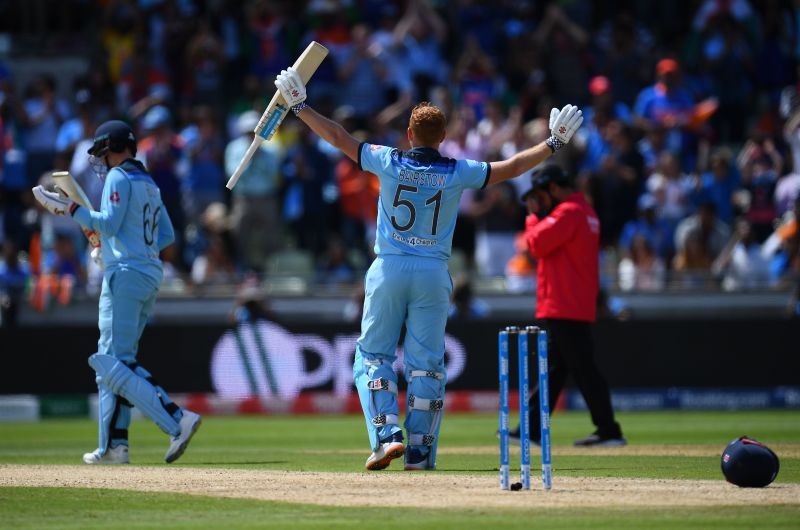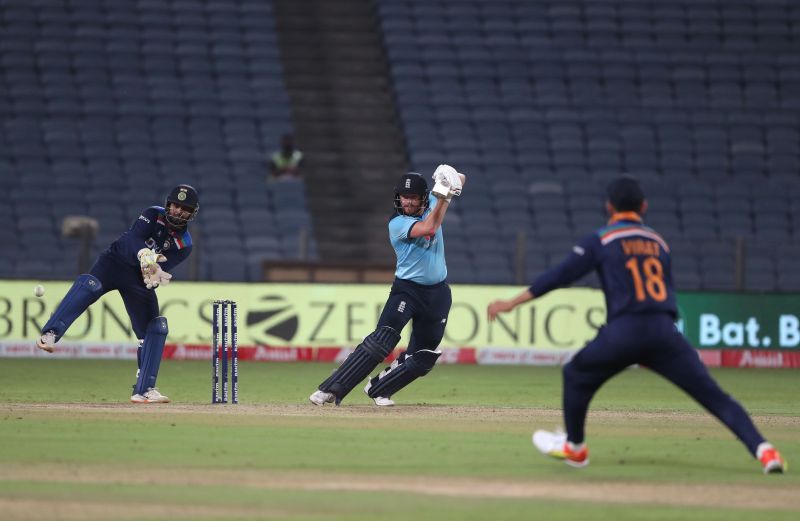
Living by the sword and dying by it - ft. Jonny Bairstow

On 9th March, 2015, England sans Jonny Bairstow succumbed to a chastening defeat at the Sydney Cricket Ground against Bangladesh. The reverse didn’t just consign the Three Lions to the ignominy of an early World Cup exit, it also opened up a can of worms, especially considering that they were perhaps at the nadir of their ODI fortunes.
In the aftermath of the game, a dejected Eoin Morgan addressed the media, honestly quipping that he was gutted and that he didn’t know what the future would hold.
“Unbelievably disappointing. I am gutted at the moment. No idea what will happen from here,” the English skipper had said.
Post the loss, England’s conservatism had been touted as one of the primary reasons for their humiliating performance at the 2015 ICC Cricket World Cup. Before the tournament, the Three Lions had rummaged through different skippers, eventually zeroing in on Morgan as captain. Prior to that, Sir Alastair Cook was at the helm, indicating the polarisation in ideologies.

Unsurprisingly, a massive overhaul engulfed English cricket over the next few months – one that eventually led to the inclusion of Adil Rashid, Liam Plunkett, Jason Roy, and of course, Jonny Bairstow. Though there were a few rough patches at the start, wherein their cavalier approach was looked upon skeptically, at least in English quarters, they tided over those excellently.
Six years later, at Pune and against India, both edges of that particular sword were perhaps felt. While the first game saw England be a little too gung-ho to lose the match, the second saw them blow India out of the water. On both occasions, though, the Three Lions maintained that belligerence was the obvious way forward. None, though, made those clamours as deafeningly as a certain Jonny Bairstow.
In the press conference that followed the 1st ODI, Eoin Morgan was buoyant in defeat. He commented that he would prefer losing via a chasing capitulation while seeking aggression rather than an agonising 10-run defeat – one that would’ve accrued due to a lack of intent.
After the 2nd ODI, though, in which England absolutely annihilated India, Jonny Bairstow offered further insight into the Three Lions’ thinking.
“Chase them down as fast as you can. That is as simple as it gets. We go out there and try to put the bowlers under pressure in order to force them into mistakes. That is the way we go about it. If it’s not my day, not Jason’s day, not Ben’s day, we have the strength in depth in our batting and we are very fortunate to have it,” Jonny Bairstow beamed.
While it reverberated similarly to what Morgan had said a couple of days earlier, it highlighted the massive role Jonny Bairstow has played in that revolution. Perhaps, Jonny Bairstow has even become England’s lynchpin, especially when chasing in ODI cricket.
To put things into context, England have chased in an ODI 49 times since the 2015 ICC Cricket World Cup. Astonishingly, they’ve won 34 of those fixtures, with only 13 losses. The remaining two games have ended in ties, with the one against New Zealand in the 2019 World Cup final being the more prominent stalemate.

Jonny Bairstow has a superlative record when batting second
Jonny Bairstow, meanwhile, has extraordinary numbers when it comes to batting second in an ODI. Across his career, he averages 48.92 and strikes at 104.74. Since the World Cup, though, when he has been used as an opener in chases, his average zings up to 58.38. Additionally, his strike rate rockets up to 115.96.
Thus, Jonny Bairstow’s comments on England wanting to finish off run chases bear even more weight, considering that he has been a pioneer for that modus operandi.
Having said that, though, there have been a few occasions where the Three Lions have floundered with their high-risk, high-reward approach, with the latest example being the botched run-chase in the 1st ODI.
Previously, that trend reared its head during another incredible batting collapse, which took place on the 23rd of October 2018 against Sri Lanka at Colombo. On that occasion, the Three Lions were set a target of 367, and they could only huff and puff their way to 132/9 before rain landed the death knell.
There have been plenty of other instances where England have looked to knock the stuffing out of opposition bowling attacks when confronted with a massive target.
Since the 2015 ICC Cricket World Cup, England have been asked to chase more than 330 nine times. Of those, they’ve remarkably won 5, which considering the circumstances, is a healthy conversion rate. Most tellingly, though, on only one occasion has the chase meandered into the 50th over (against Pakistan at Nottingham in 2019).
To put things into perspective, England hunted down 350 against New Zealand at Trent Bridge in 2015 in 44 overs. They repeated the dose against the West Indies in February 2019, when they scaled down 361 inside 49 overs.
The remaining run-heists involved Jonny Bairstow plundering the opposition bowling attacks into submission – something that allowed England to breeze past India (at Pune in 2021) and Pakistan (at Bristol in 2019).
At times, though, England’s propensity to flirt with fire has meant that they’ve crashed and burned, quite spectacularly too. Yet, what has remained the same has been their firebrand philosophy – one that gains importance considering how the failed run chases have unfolded.
In the 4 losses that they have suffered while crafting a 330-plus run chase, they’ve been 8 or more wickets down each time – again, something that emphasizes their boom or bust brand of cricket. However, their ultra-aggressive nature has also allowed them to get somewhere close to these targets.
Moreover, of the 13 times England have lost chasing any kind of score since the 2015 World Cup, four came before 2018 and at a time when the Three Lions were still adapting to Eoin Morgan’s style. Also, at that point, Jonny Bairstow was not a regular, and that perhaps answers the anomaly as much as anything else.

In the 1st ODI, England were largely panned for withering a humongous advantage – one that Jonny Bairstow had fashioned (primarily). Even then, they perished while playing their strokes. In fact, Jonny Bairstow, who was batting on 94 at the time, didn’t pay heed to personal milestones and looked to target Shardul Thakur, who, prior to that spell, had leaked runs.
Hence, there could be a tangible theory suggesting that Jonny Bairstow perhaps embodies England’s white-ball revolution and that he remains one of their most vital cogs.
Not just because he has bludgeoned runs for fun since his elevation to the top of the order, but also because there are very few cricketers who throw caution to the wind quite like Jonny Bairstow. And then there is also the small matter of him prioritising the collective in his inimitable, bellicose manner.
Subsequently, Jonny Bairstow’s comment on there being a method to the English white-ball madness makes even more sense, considering he has, in essence, masterminded quite a significant chunk of it.

Though the average cricket fan might find it tough to decipher the exact thought-processes, the English faithful would be gleaming, for Jonny Bairstow - their batting mainstay has it all figured out.
Over the past few years, England have effusively stated that they intend to live by the sword and risk dying by it. And, perhaps none personifies that adage as much as Jonny Bairstow.
Back in 2015, Eoin Morgan simply couldn’t understand what to expect and where his team were heading. Six years on, though, he certainly knows the general direction his team intends to traverse. More fortunately, he has one Jonny Bairstow to help navigate through potentially tricky run-chasing terrains.
As simple as it gets, isn’t it? At least, that’s what Jonny Bairstow thinks.